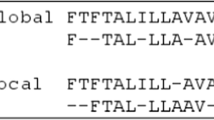Abstract
The study and comparison of sequences of characters from a finite alphabet is relevant to various areas of science, notably molecular biology. The measurement of sequence similarity involves the consideration of the possible sequence alignments in order to find an optimal one for which the “distance” between sequences is minimum. In biology informatics area, it is a more important and difficult problem due to the long length (100 at least) of sequence, this cause the compute complexity and large memory require. By associating a path in a lattice to each alignment, a geometric insight can be brought into the problem of finding an optimal alignment, this give an obvious encoding of each path. This problem can be solved by applying genetic algorithm, which is more efficient than dynamic programming and hidden Markov model using commomly now.
Similar content being viewed by others
References
Sankoff D, J B Kruskal, Time Warps.String Edits and Macromolecules: the Theory and Practice of Sequence Comparison. London: Addison-Wesley, 1983.
Snakoff D. Simultaneous Solution of the RNA Folding, Alignment and Protosequence Problem.SIAM J Appl Math, 1985,45:810–825.
Anders K, Michael B, I Saira Mian,et al. Hidden Markov Models in Computational Biology Applications to Protein Modeling.J Mol BIOL, 1994,235: 1501–1531.
Carrillo H, Lipman D J. The Multiple Sequence Alignment Problem in Biology.SIAM J Apple Math, 1988,48:1073–1082.
M Fitch, T F Smith. Optimal Sequence Alignment.Proc Nat Acad Sci USA., 1983,80:1382–1386.
Gotho O. Alignment of Three Biological Sequences with an Efficient Traceback, Procedure.J Theor Biol, 1986,121:327–337.
Gotho O. Optimal Sequence Alignment allowing For long aps.Bull Math Boil, 1990,52:359–373.
Kruskal J B. An Overwiew of Sequence Comparison: Time Warps, String Edits and Macromolecules.Slam J Appl Math Rev, 1983,25:201–273.
Needleman S B, C D Wunsch. A General Method Applicable to the Search for Similarities in the Amino Acid Sequence of Two Proteins.J Molec Biol, 1970,48:443–453.
Reeves C R. A Genetic Algorithm for Flowshop Sequencing.Computes OpsRes, 1995,22:5–13.
Author information
Authors and Affiliations
Additional information
Foundation item: Supported by Zi-qiang Foundation of Wuhan University and Open Foundation of the State Key-Laboratory of Software Engineering, Wuhan University
Biography: Shi Feng(1966-), male, Associate professor, research direction: bioinformatics.
Rights and permissions
About this article
Cite this article
Feng, S., Jing, H., Zhong-xi, M. et al. A genetic algorithm on multiple sequences alignment problems in biology. Wuhan Univ. J. Nat. Sci. 7, 139–144 (2002). https://doi.org/10.1007/BF02830301
Received:
Issue Date:
DOI: https://doi.org/10.1007/BF02830301




